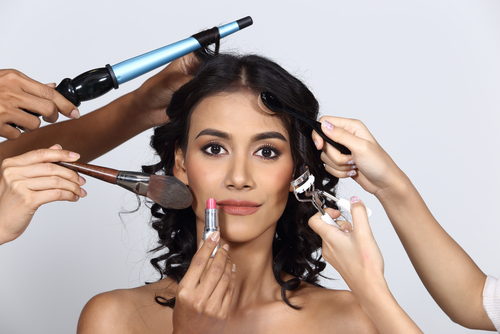Celebrating Black Beauty At the ‘Hairdresser’s Fashion Week.’
“It’s a hairdresser’s fashion week,” said Dwight Eubanks, who had just stepped off the stage from judging the Champion of Weaves competition at the Bronner Bros. International Beauty Show in Atlanta. Mr. Eubanks is a Bronner Bros. devotee and has been coming to the event since he was 16. “The future is looking really good, the students are really excited about the craftsmanship.”
Mr. Eubanks and 30,000 other attendees came together over a three-day stretch this month to what is now the largest multicultural beauty trade show in the world. They are part of a community that has formed around this event, which offers hairstylists, makeup artists and attendees the space to create and showcase the styles that reflect a celebration of the versatility of black hair.On view at a recent show this month were playful weaves and extensions in vivid hues, natural cuts, dreadlocks and braids that were structures as much as styles.
“We don’t have a show on this level where we, as stylists, are able to get educated like this,” said Anya Parker, who has been attending the show for 10 years from Memphis. “I will probably come here until I’m dead and gone.”
It all started over 70 years ago. Nathaniel Bronner studied business at Morehouse College in the 1930s, but it took a literal sign for him to realize his true calling. “Beauty: the depression-proof business,” it read. So he decided to go to cosmetology school in the historically black neighborhood of Sweet Auburn in Atlanta and soon after started a company with his brother, selling the hair products from their sister’s salon on his newspaper sales route.
The next step was a hair trade show. Their first took place in 1947 in the basement of a Y.M.C.A. in Atlanta, drawing 40 exhibitors and hairstylists from local salons and 300 attendees.
The event may not have seemed significant. But it was. African-Americans interested in creating consumer products reacted to their exclusion from mainstream companies by building a parallel beauty industry focused on hair. It resulted in self-made successes, including Annie Turnbo Malone, a child of former slaves who sold her wares in the early 20th century, and Ms. Malone’s protégée, Madam C.J. Walker, the first black millionaire in America.
The Bronners would become a big player in this ecosystem. The Bronner Bros., now still family run by some of the heirs, has become a cultural touchstone for African-Americans in the industry and beyond, with notable guest speakers having included the Rev. Dr. Martin Luther King Jr. and Jackie Robinson. It was a stand-in for the black beauty industry in the Chris Rock movie “Good Hair,” which, among other things, explores whether the desire for straight hair reflects a Eurocentric standard of beauty.
While the show may have gotten its bearings at a time when straightening was the main process for styling black hair, that was never the case at Bronner Bros. The show was an event that created a space for black men and black women, who are still largely ignored by the mainstream beauty industry.
Each year African-American women spend about $7.5 billion on beauty products, according to findings from Essence’s Smart Beauty panel in 2009. Black women spend twice as much on skin care products and 80 percent more money on cosmetics than the overall market.
“The general market didn’t really wake up to it until basically the statistical data came out,” said James Bronner, Nathaniel Bronner’s youngest son and the trade show director of Bronner Bros.
The African-American market is beginning to be noticed: L’Oréal started a Women of Color Lab and Paul Mitchell announced their new line targeting textured hair at the Bronner Bros. show in 2015. At the same time, some companies that started out focusing on black consumers, including Carol’s Daughter, which was acquired by L’Oréal in 2014, and Shea Moisture are now marketing to a broader base. At the Bronner Bros. show, there is little doubt about the target customer.
The African-American market is beginning to be noticed: L’Oréal started a Women of Color Lab and Paul Mitchell announced their new line targeting textured hair at the Bronner Bros. show in 2015. At the same time, some companies that started out focusing on black consumers, including Carol’s Daughter, which was acquired by L’Oréal in 2014, and Shea Moisture are now marketing to a broader base. At the Bronner Bros. show, there is little doubt about the target customer.
The Bronner Bros. show is best known for its extravagant competitions, such as hair battles, which in past years have involved cutting hair underwater and hanging on a trapeze. The event this month was packed with classes and live demonstrations including ones on loc reconstruction, achieving the perfect fade, braiding and weave-stitching techniques by well-known hairstylists and brands. The show also included discussions on what it means to wear hair natural in Western society and how the media influences the perception of black beauty.
This year’s two main competitions were Champion of Weaves and the Fantasy competition with a superheroes theme, where stylists had to create a look by styling models with outfits and lavish hair constructs.
Everywhere you turned on the floor of the convention center were eye-catching hairstyles like pink braids, blue weaves, natural curls and dreadlocks, and women and a few men alike wore glitter makeup and flamboyant outfits.
For beauticians, hairstylists, hair models and guests, it’s the place to be and be seen. And everyone comes dressed for the occasion.

